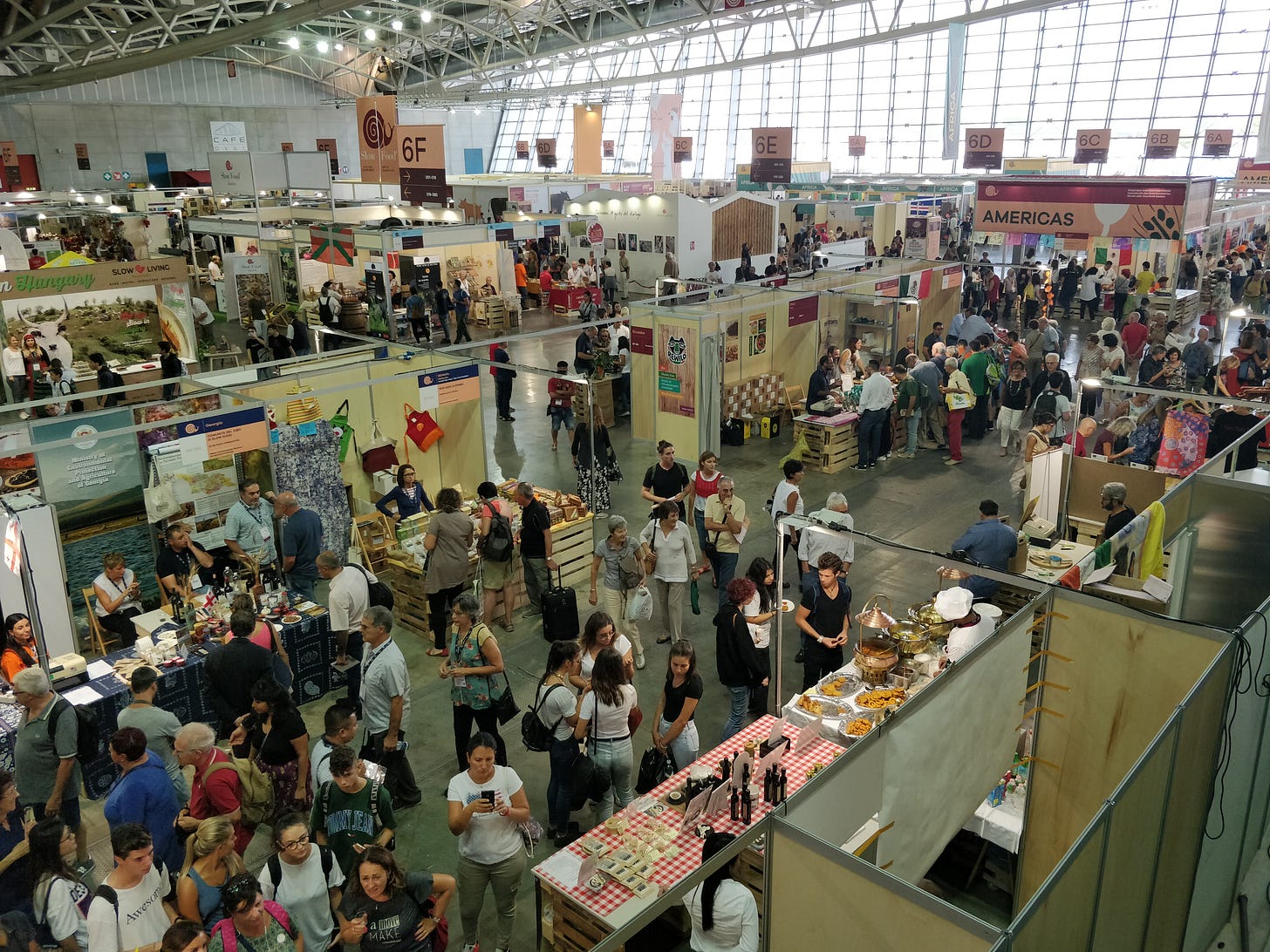Calling Mother Earth
A newsletter about food systems, climate change and everything connected to them
Terra Madre goes online
Every two years, Slow Food organises its famous Terra Madre Salone del Gusto event in Torino in October, celebrating delicious food from Italy and around the world produced fairly and in an environmentally-conscious manner. Culinary events are held in and around the city’s stunning baroque buildings but the real buzz is in the cavernous exhibition space in Lingotto where hundreds of food stalls showcase their wares. I was fortunate enough to cover the event in 2018, tasting fonio cooked by Senegalese chef Pierre Thiam, finding out about nutritious local ‘weeds’ in Cape Town, speaking to pastoralists from Africa and discovering efforts to improve nutrition in the Navajo Nation.
Alas, the coronavirus upended the 2020 event but the organisers have adapted and brought many of the sessions online. It will also run until April 2021. In some ways, this is for the better because you don’t have to be in Torino physically. Check out what’s on offer on their website and if you so wish - and live in the Schengen region - you can even buy cheeses, wines and charcuterie from many of their exhibitors. Delivery is by refrigerated courier within 72 hours, according to the organisers.
For that, we have extensive and reliable cold chains to thank. But running these cold storage facilities is very energy intensive and there are now efforts to switch to renewables and build net zero cold chain infrastructure. I’m planning a story on this topic.
Adaptation Number Crunching
Earlier this week, the Dutch government hosted a global summit on climate adaptation, and like many events in these pandemic times, much of it was virtual.
The event highlighted the need to step up on actions to adapt, not just mitigate, to climate change. These could include things like helping farmers to grow crops that are more resilient to droughts and floods, building urban parks to keep cities cool amid rising temperatures and finding ways to use water more efficiently. The argument is that it is no longer enough to just talk about cutting emissions because the impacts are already locked in.
This piece by my former colleague and climate finance guru Megan Rowling sums up the event well - that despite dire warnings, including from the U.S. climate envoy John Kerry, concrete progress is still slow.
But I wanted to highlight some interesting numbers from the session on agriculture and food systems. I hope to follow up on some of these numbers.
“We have seen that, farmers, because of climate change, are increasingly using more land than they would have because they are producing less from the land of the use. In fact 30% of production, for example in the African continent, is coming from using more land.”
Agnes Kalibata, U.N. Secretary General’s Special Envoy for the 2021 Food Systems Summit
“Every year the top 50 food producing countries… pour $700 billion in support for often destructive land use - that's around four times the world's aid budgets combined. Coincidentally, it's also roughly what scientists estimate we're going to need to spend to reverse environmental destruction and to help nature recover. So imagine the impact if even part of this funding support could be redirected to help farmers transition to climate friendly nature positive land management.”
Zac Goldsmith, Minister for Pacific and the Environment, UK
“We talk a lot in climate finance about how much is being spent. But we really need to talk a lot more about how that money is being spent. There's a very disgraceful figure that only 10% of climate finance reaches the local level. We're really keen to encourage a coalition of donors to get behind the LIFE-AR initiative which aims to move that figure… to 70%.”
Sinead Walsh, Deputy Director General for Irish Aid and Ireland’s climate envoy
Hitting Gold Dirt
I mentioned regenerative agriculture in last week’s introduction to this newsletter. This episode from one of our favourite podcasts, How to Save a Planet, is all about loving the soil. It features Leah Penniman, an inspiring Black farmer I spoke to for my longform piece last Summer about people tackling food apartheid in the U.S. It’s worth an hour of your time.
Death Knell on the Green Revolution?
If you’re interested in food and agriculture, you’ve heard of the wonders of the Green Revolution, which dramatically boosted harvests in poor parts of the world by introducing high-yielding seeds, fertilisers and irrigation in the 1960s and 1970s and averted a hunger crisis in many places. But there has been criticism in recent years that the Green Revolution accelerated ecological destruction and didn’t really help poor farmers. This opinion piece in Scientific American firmly belongs in the latter camp, arguing that the farmer protests raging in India are based on years of discontent built up by the failure of the Green Revolution.
Inform or Persuade?
Last week, I touched on the topic of science communications. Yesterday (Jan 28), we had a really interesting virtual discussion on how to communicate about food and agriculture issues, as part of the Swedish International Agriculture Network Initiative’s annual meeting. The attendees were academics, scientists and comms professionals from all over the world - Philippines, Tanzania, Pakistan, Sweden, just to name a few. You can watch the discussion here.
There were lots of interesting strands - How do you communicate complex scientific research and findings? How do you add nuance and context to black-and-white debates which we’re seeing now around livestock and meat consumption? How do you deal with increasing polarisation on social media? - but one particular point that got me thinking.
“Are we trying to inform or persuade?”, asked Michael Victor, head of communications at the International Livestock Research Institute (ILRI), part of the CGIAR network of agricultural research centres. To him, science communications around food security isn’t about persuading but informing people by providing evidence. I think the same is true for journalism, or at least the kind of journalism most of us have been exposed to.
But an attendee asked how we could then counter persuasive lies and anti-science narratives that are repeated over and over again? We suggested building trust, speaking in a language people understand, and using the right messengers, but this is something both journalists and comms professionals have all been struggling with and I’d be interested to hear what your thoughts are.
Do share them in comments, via e-mail (thin@thin-ink.net), twitter @thinink, or a LinkedIn message.
Have a great weekend!




